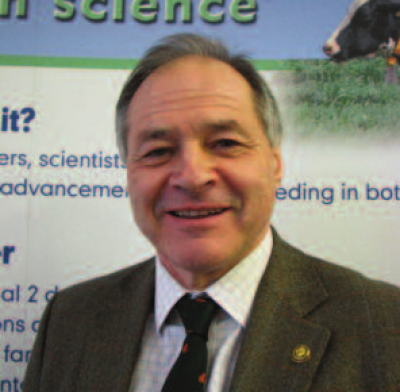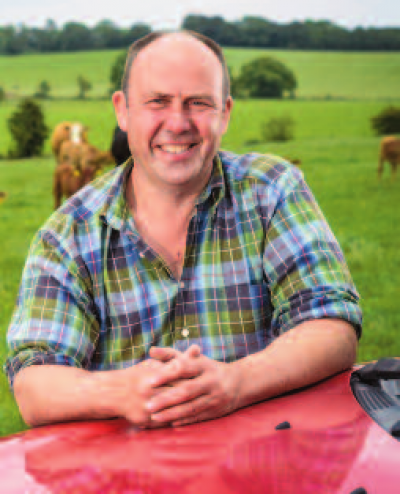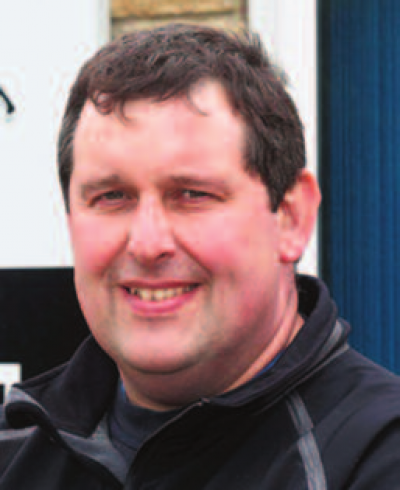Conference: Intro
A message from the BCBC chairman

In recent years, attendance at the British Cattle Breeders’ Club Conference has been excellent. Next year, we will address the theme of ‘The Business of Breeding,’ and I believe we can continue to build on the industry relevance which has been nurtured.
As we approach 2016, the cattle farming industry finds itself in significantly different circumstances. Despite the financial challenges, I hope you will view the Conference as two days well-used, with informal discussion with other delegates really adding to the programme itself.
If you would like a taster from the 2015 event, please dip into the Talking Slides homepage.
While breeding is the foundation of any cattle enterprise, it cannot stand alone. We must continue to understand and adapt to market requirements.
Yet cattle breeding is a long term project, unable to adjust overnight to changing expectations or rewards.
Even so, our industry has much to be proud of and great strides are being made. None more so than in the genomics arena – although it is important to recognise that there is much more than just genomics to the future.
Bovine TB resistance will be covered on day one, with planning for the future from a successful farmer, an entrepreneur, and a Dutch perspective also on the programme.
It is my privilege to be chairman for the 2016 Conference and I look forward to welcoming you to Telford on Tuesday 19 and Wednesday 20 January.
Roger Trewhella
Conference: The Speakers
David Black - Advanced Breeding Technology Advances for Cattle Farmers

Cattle fertility continues to fall worldwide and the global human population is predicted to reach 9 billion by 2050, accompanied by an ever-increasing need for sustainable protein production. There is, therefore, a requirement to amplify and exploit existing genetics and improve cattle production efficiencies. The techniques of Ovum Pickup (OPU) and In-Vitro Embryo Production (IVP) have significant advantages over both traditional breeding programmes and the use of conventional multiple ovulation embryo transfer (MOET).
The process is non-surgical and requires minimal treatment other than epidural anaesthesia, minimising clinical risks and pharmacological interventions. OPU collections can be performed more frequently, so more oocytes can be collected in a shorter time period. Oocytes can be collected from both juvenile heifers and pregnant donors during the first trimester, extending the number of potential embryos which can be produced. The technique can be used on animals with a range of reproductive disorders which might not otherwise be able to continue breeding. Less semen is used per fertilisation, so multiple donors can be fertilised with a single straw - saving money and utilising limited semen stocks. A wide range of bulls can be used, due to the frequency of collection, giving greater scope for genetic improvement.
The optimisation and application of genomics-based selection regimes are a fundamental worldwide goal, if the food production industry is to meet growing demands. Cattle breeders increasingly make use of single nucleotide polymorphism arrays (SNP chips), to assess the genetic merit of animals and these have proven to be more efficient and cheaper than traditional progeny testing, while increasing selection pressure and greatly expediting the introduction of superior genetics into the breeding herd. Traits targeted using SNP chips include somatic cell count, daughter pregnancy rate, productive life, stillbirth rate, calving difficulty, etc. This technology has opened up possibilities for increased power to select for low heritability traits.
The advantage of SNP chip use is its multiplicity - it is potentially applicable for any trait. The major disadvantage is the cost (monetary and environmental) of taking pregnancies to term, before the testing of offspring and subsequent introduction to the breeding programme. But with recent developments, advanced breeding technologies can be combined with state-of-the-art genomic screening of embryos (so called pre-implantation genetic diagnosis), and karyomapping (combining parental DNA information with the offspring's genomic information to provide greater genetic detail), to deliver superior genetics more efficiently to the breeding herd.
This will reduce the production and rearing of unwanted offspring, which also raises ethical concerns and increases the carbon footprint of cattle production. Conversely, an artificial insemination (AI) stud bull is worth many thousands of pounds and young candidate sires can be marketed from 2 years old, if the SNP chip indicates that they have sufficient genetic merit.
Commercial farmers will more readily be able to select genetics that suit their farm or ambitions, such as disease resistance – bovine TB is one example - or health traits (eg longevity). OPU and IVP are widely used in other parts of the world, especially with bos indicus cattle, which seem more suited to these techniques, but they are now available in the UK and Europe. The embryo genomic techniques are at an early stage of development, with initial markets being the elite breeders, but these are likely to become mainstream breeding tools for all cattle in the future.
Gwyn Jones - Making a Future in Dairy Farming

The signals for dairy farmers have been mixed in recent times.
On the one hand, there is great demand and opportunity as the world’s population gets richer and access to dairy products improves.
On the other hand, there is the downside of market volatility causing problems for planned production and returns.
Making a future in this environment requires good planning, good business systems, good market intelligence and high quality technical performance.
AHDB Dairy aims to provide all these, to support British dairy farmers in their efforts to forge a successful future in dairy farming.
Keith Davis - The Use of the UK Breeding Indices within my Herds

I am a partner in a family dairy farming partnership, which includes my brother and our wives. The partnership was started by our grandfather and father, when they purchased the farm in the Forest of Dean in 1952. We now milk 125 high-output Holstein cows which are block-calved in the autumn. They are milked through two Lely Astronaut A3 robots. I also manage the dairy unit at Lydney Park Estate for Lord Bledisloe; the holding supports 800 Jersey cross cows, milked once a day on a low cost, grass-based system.
The breeding policy for the family partnership never seemed to have any continuity or focus until the late 1990s, when we started to use PIN, an early form of PLI. Prior to this approach, breeding decisions lacked continuity and direction, although we always believed we were trying to breed a profitable cow.
In 2001, the herd was unfortunately slaughtered out due to foot-and-mouth, but one thing that had become very apparent to us just prior to this was the quality of the animals that we had bred using the PIN index. So on re-stocking the farm, we made the decision to use PIN as the sole criteria for the purchase of the replacement herd. The ultimate aim was to have a high output, block-calved herd that was in the top 1% for genetics measured on PIN at that time, but now PLI.
Over the following years, I became the manager of the dairy unit at Lydney Park Estate. It was converted to a low cost, grass-based system from a fully housed operation, due to the buildings’ close proximity to a large expanse of potential grazing. However, it quickly became obvious that the PLI was not quite the correct index to be used for breeding the type of animal suitable for a low-cost grazing system.
I was keen, having had success with PLI, to find a similar index for breeding decisions for this type of system and quickly found the New Zealand BW index. We started using this and it helped us make rapid improvement in the type of animal coming into the herd.
We have since started using the Irish EBI index, because we thought it was slightly more appropriate to the Northern Hemisphere climate and milk pricing system. This year, we started using the new SCI index, which from now on will be our main decision-making index, simply because it is formulated specifically for the UK.
At the family farm today, our herd of block-calved (5 July – 10 October) Holstein cows is not only high output, but fertile and easy to manage; just by chance we have the highest PLI herd in the UK. At Lydney Park Estate, we are well on the way to having very fertile herd, with calving taking place from 4 February-18 April. The cows produce excellent levels of fat and protein, with very little concentrate input and the potential for grazing for most of the year.
Kim Matthews - Improving Carcase and Eating Quality through Breeding and Management

The objectives of rearing cattle for beef include producing as much meat as possible, of the highest possible quality, sustainably and profitably.
This paper will provide an overview of some current and recent research projects aimed at helping the beef industry to do just that.
Data, from abattoirs and other national databases, is suitable for producing national beef genetic evaluations for the traits farmers are paid for.
A project that is nearing completion focuses on producing genetic evaluations for carcase weight, conformation and fat class, for breeds with sufficient data.
The correct age limit for quality beef production from steers and heifers is often debated.
With some prime beef cattle not being ready for slaughter until 30-36 months of age, there is a need to know if meat from these older cattle is tougher and the paper will also cover this topic.
Billy O’Kane - Driving Beef Profitability using Maternal Composite Genetics

The biggest risk facing the UK beef industry is reduced per capita consumption, due to competition from cheaper, more efficiently produced meats like chicken and pork. To counteract this, as an industry we must ruthlessly improve the efficiency of beef production, rather than constantly demanding higher farm-gate prices and subsidies.
There are many useful lessons that can be learnt from our competitor industries – mainly focused on the use of specialist hybrid maternal genetics.
Two Facts:
- The biggest profit driver in suckler beef production is total kilos of calves weaned per hectare and the biggest influence on this is cow type.
- Approximately two thirds of the cost of producing a kilo of suckler beef is the cost of keeping the cow.
Taking these together, it is clear that suckler farms need to use cows which cost less to keep and have a higher relative output, ie efficient cows. Various trials, including those on our own farm, have demonstrated that using the best maternal genetics alone can improve total kilos weaned per hectare by up to 30% and net profit per cow by up to £300.
If we get cow type right, we can use whichever terminal sire suits our farm system. If we get cow type wrong, it is virtually impossible to make money.
Maternal Profit Drivers
Fertility – Our farm has moved from 10% empty in 12 weeks to 3% empty in 9 weeks.
Calving Interval – 400 days to 361 days
Birth Assistance – 25% to 3%
Birth Mortality – 5% to 2%
The combination of these factors has seen calves weaned per 100 cows put to bull rise from 83 to 95 and calving move from indoor with 24-hour supervision to an outdoor system, with cows checked twice daily. This has also improved our quality of life.
Cow size/weight – bigger, heavier cows do not wean bigger, heavier calves. AHDB Beef and Lamb, DARD and Teagasc figures all show that 600kg cows wean the same weight of calves as 800kg cows. More of the smaller cows can be kept on the same land area at minimal extra cost, resulting in substantially more kilos weaned per hectare. This is expressed in the cow efficiency percentage, defined as: Total kilos of calves weaned at 200 days divided by total kilos of cows put to the bull.
The UK average is below 40%, while US agri-economists say that 50% is the figure generally regarded as giving sustainable profit. This is much easier to achieve with smaller cows and increasingly difficult when cow weights exceed 650kg. The average cow weight in our herd is 620kg.
Two Year Old Calving
Virtually all large-scale beef producing countries in the world calve heifers at 2 years old. Compared with 3-year-old calving, this increases net profit by over £40 per cow per year, for every year of her life. So early puberty-type cows, preferably containing at least 50% native breed influence, plus good heifer rearing, are necessary factors.
Dr Donagh Berry - Beefing up Beef Breeding in Ireland, using DNA Technology

The trials and tribulations of embarking on a national, DNA-based, multi-breed genomic selection cattle breeding program in Ireland will be discussed. The talk will cover aspects such as why one would embark on such a massive endeavour, as well as the expected short, medium and long-term benefits of such an approach.
DNA-based technologies can, at the very least, ‘clean up’ the pedigree of animals; approximately 8.5% parentage errors exist in Ireland. One of the main benefits of exploiting DNA-based technologies includes an increase in the accuracy of genetic evaluations, which materialise into reduced fluctuations in animal proofs, as more information on the animal and its relatives accumulates.
The lessons learnt and potential pitfalls for other countries considering a large-scale genotyping initiative will also be covered. Ireland uses its own, specifically-developed custom genotyping platform and the process of developing this platform, as well as the pro's and con's of such an approach, will be addressed. The cost of procuring a DNA profile on an individual animal is decreasing annually; the cost of generating a DNA profile for Irish farmers is now 6% of the figure when the original research began in 2008.
Ireland has the largest genomic selection reference population internationally for beef cattle and thus the issues encountered are likely to represent issues that other countries will be confronted with in the near future.
The results of the initiative will also be presented. These include detection and amendment (where necessary) of incorrect parentage assignment, the ability to monitor the change in allele frequency of loci of importance; myostatin, for example, as well as an increase in selection accuracy.
Future plans for the Irish beef genomic selection breeding program include the generation of billions of data points on millions of animals and how genomic technologies can be used, beyond simply inclusion in breeding programmes.
Philip Metcalfe - Keeping on Track and Staying There

Philip and his brothers, David and Brian, run a 2,700-acre farm, milking 900 pedigree Holsteins currently averaging 10,800 litres.
Building is underway for a further 400 cows and a new 72-point rotary parlour is being installed.
Other businesses run by the brothers include agricultural contracting, heavy haulage (with 80 lorries) and an anaerobic digester.
Metcalfe Farms were RABDF Gold Cup finalists in 2015.
Philip will talk about all aspects of the dairy, and in detail try to show how technology has helped the performance and welfare of the Washfold Herd.
He will outline his experiences, both good and bad!
He will also discuss cattle breeding and how genomics is likely to have an impact in the future, as well as highlighting the areas where technology might prove most useful.
Conference: Sponsors
Grateful thanks go to our major sponsors:
ASDA, Mole Valley Farmers, AHDB Dairy, Illumina and Waitrose.
Conference: The time and place
Conference Venue
The Cattle Breeders Conference 2016 will be held at the Telford Hotel and Golf Resort in Shropshire on 19 and 20 January 2016.
Conference Travel
The local train station, at Telford, is approximately five miles away. Birmingham International Airport is 40 miles away.
For more information, including booking online, see the Conference section and for details on how to join the BCBC see the Joining page.
Alternatively contact the secretary:
Heidi Bradbury, Underhill Farm, Glutton Bridge, Earl Sterndale, Buxton, Derbyshire, SK17 0RN.
Tel: 07966 032079.
heidi.bradbury@cattlebreeders.org.uk